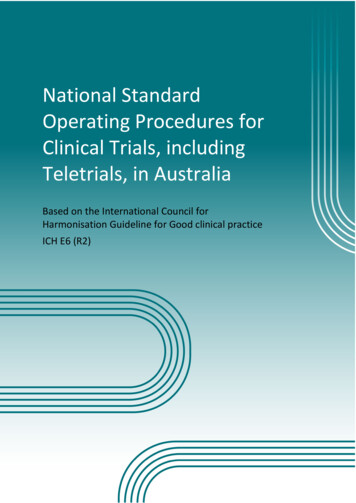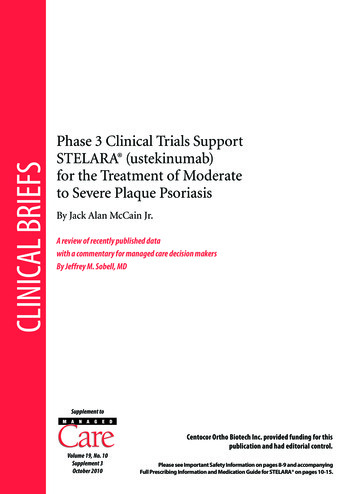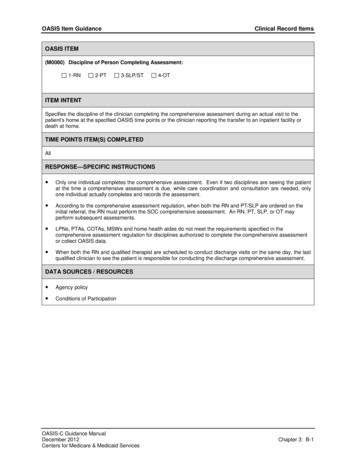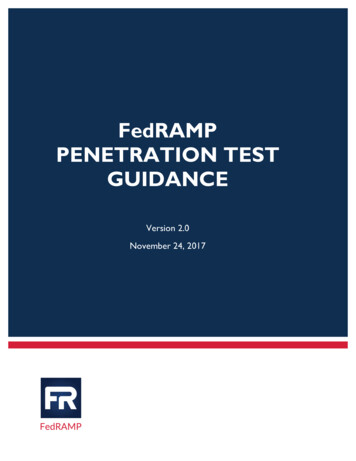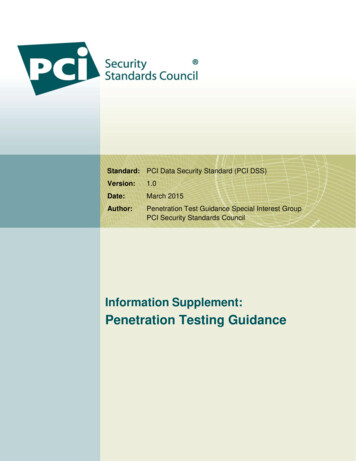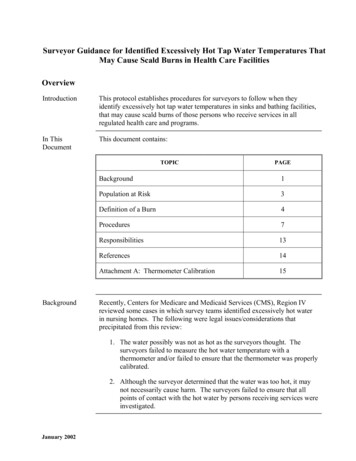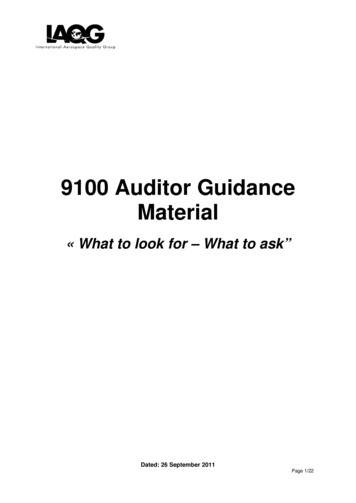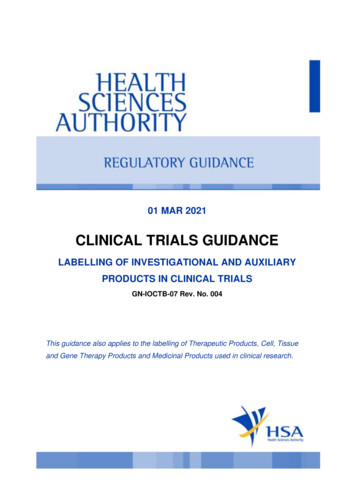
Transcription
01 MAR 2021CLINICAL TRIALS GUIDANCELABELLING OF INVESTIGATIONAL AND AUXILIARYPRODUCTS IN CLINICAL TRIALSGN-IOCTB-07 Rev. No. 004This guidance also applies to the labelling of Therapeutic Products, Cell, Tissueand Gene Therapy Products and Medicinal Products used in clinical research.
LABELLING OF IP AND AP IN CLINICAL TRIALS01 MAR 2021PREFACEThis document is intended to provide general guidance. Although we have tried toensure that the information contained here is accurate, we do not, however, warrantits accuracy or completeness. The Health Sciences Authority (HSA) accepts no liabilityfor any errors or omissions in this document, or for any action / decision taken or nottaken as a result of using this document. If you need specific legal or professionaladvice, you should consult your own legal or other relevant professional advisers.In the event of any contradiction between the contents of this document and anywritten law, the latter should take precedence.CONTACT INFORMATIONFor further information, please contact:Innovation Office & Clinical Trials BranchHealth Products Regulation GroupHealth Sciences Authority11 Biopolis Way, #11-01, HeliosSingapore 138667Email: HSA CT@hsa.gov.sgWebsite: www.hsa.gov.sgHEALTH SCIENCES AUTHORITY – HEALTH PRODUCTS REGULATION GROUPPage 2 of 29
LABELLING OF IP AND AP IN CLINICAL TRIALS01 MAR 2021REVISION HISTORYGuidance Version (Version Date)GN-CTB-2-003D-001 (01 Nov 2016)GN-CTB-2-003D-002 (02 May 2017)GN-CTB-2-003D-003 (31 Jan 2018)GN-IOCTB-07 Rev. No. 004 (01 Mar 2021)SUMMARY OF KEY AMENDMENTS Added a new category of health products, i.e., Cell, Tissue and Gene TherapyProducts (CTGTPs), that is regulated under the Health Products Act Updated list of labelling elements that may be omitted (Section 3) Updated Scenarios for re-labelling (Section 5.1) Updated Frequently Asked Questions (Section 6) Updated Reasons for Labelling Omissions Form (Appendix B)HEALTH SCIENCES AUTHORITY – HEALTH PRODUCTS REGULATION GROUPPage 3 of 29
LABELLING OF IP AND AP IN CLINICAL TRIALS01 MAR 2021TABLE OF CONTENTS1. INTRODUCTION . 51.1. Purpose . 51.2. Background. 51.3. Scope . 72. DEFINITIONS . 83. LIARY PRODUCTS USED IN CLINICAL TRIAL . 94. HANDLING SITUATIONS WHERE LABELLING ELEMENTS ARE OMITTED . 164.1. Scenarios where the Reasons for Labelling Omissions Form is not required tobe submitted to HSA . 164.2. Notification Process . 185. HANDLING SITUATIONS WHERE RE-LABELLING IS REQUIRED . 205.1. Scenarios where re-labelling may be required . 205.2. Re-labelling process . 206. FREQUENTLY ASKED QUESTIONS (FAQ) . 217. REFERENCES . 238. APPENDICES . 248.1. Appendix A – Situations where omission of labelling elements may beconsidered acceptable . 248.2. Appendix B – Reasons for Labelling Omissions Form . 27HEALTH SCIENCES AUTHORITY – HEALTH PRODUCTS REGULATION GROUPPage 4 of 29
LABELLING OF IP AND AP IN CLINICAL TRIALS01 MAR 20211. INTRODUCTION1.1. PurposeThe document serves to provide guidance to the industry on the following:(a) Labelling elements and requirements for Therapeutic Products1, Cell, Tissueand Gene Therapy Products (CTGTPs)1 and Medicinal Products2 used inclinical research, including clinical trials regulated by the Health SciencesAuthority (HSA);(b) Handling situations where labelling elements are omitted; and(c) Handling situations where re-labelling is required.1.2. BackgroundProduct labelling is an important aspect in the use of the Therapeutic Products,CTGTPs and Medicinal Products in clinical research.Appropriate labelling ensures the protection of trial/research participants throughthe identification of the product and trial, the proper use and storage of the productand the enabling of product tracking from manufacture, import, and supply, to itsreturn and destruction. Therefore, appropriate labelling should be applied acrossthe entire product supply chain (Figure 1). In other words, all persons (e.g.manufacturers, importers, suppliers including sponsors and investigators) whosupply investigational products and auxiliary products for the purpose of a clinicalresearch have the responsibility to ensure that the product labels comply with theapplicable regulations.1Therapeutic Product and CTGTP are defined in the First Schedule of the Health Products Act.2Medicinal Product is defined in the Medicines Act.HEALTH SCIENCES AUTHORITY – HEALTH PRODUCTS REGULATION GROUPPage 5 of 29
LABELLING OF IP AND AP IN CLINICAL TRIALS01 MAR 2021Figure 1. Product supply chainLocal SourceLabelling requirements apply across supply chainOverseas SourceImporter* Local manufacturer (excludingmanufacture at trial site)* Supplier (excluding supply fromhospital stock)*Supply bywholesaleSupplier* Local manufacturer (formanufacture at trial site)*Supplier (for supply fromhospital stock)*Supply toparticipantsSupplier (Investigator)Participants in clinical research,including regulated clinical trials* The local sponsor can be any of these parties.Applicable regulations for labelling requirements(a) Regulated clinical trials(i)Supply at wholesale level Health Products (Clinical Research Materials) Regulations Medicines (Medicinal Products as Clinical Research Materials) Regulations(ii)Supply to trial participants Health Products (Clinical Trials) Regulations Medicines (Clinical Trials) Regulations(b) Clinical research not regulated by HSA(i) Supply at wholesale level and supply to research participants Health Products (Clinical Research Materials) Regulations Medicines (Medicinal Products as Clinical Research Materials) RegulationsHEALTH SCIENCES AUTHORITY – HEALTH PRODUCTS REGULATION GROUPPage 6 of 29
LABELLING OF IP AND AP IN CLINICAL TRIALS01 MAR 2021With the globalisation of clinical trials, clinical trials are now often conducted acrossmultiple regions of the world. In order to facilitate multi-regional clinical trials, HSAhas aligned the labelling elements in the regulations with internationallyharmonised product labelling requirements.Furthermore, innovative approaches and technology have been implemented tomanage the tracking and accountability of investigational products and auxiliaryproducts used in clinical trials. For example, computerised technologies likeinteractive voice response systems (IVRS) or interactive web response systems(IWRS) have been used to manage randomisation, investigational productaccountability at trial sites, dose titration, emergency unblinding and expiry dateupdating for clinical trials. A measured degree of flexibility has thus been includedin the regulations to allow for alternative approaches to the labelling requirements,provided the principles of labelling are not compromised.1.3. ScopeThis guidance applies to Therapeutic Products, CTGTPs and Medicinal Productsmanufactured, imported or supplied for use in accordance with the researchprotocol, for the following types of clinical research conducted in Singapore:(a) Regulated Clinical Trials(i) Clinical trials of Therapeutic Products and Class 2 CTGTPs3 that aresubject to the requirements for a Clinical Trials Authorisation (CTA) orClinical Trials Notification (CTN)3Class 1 and Class 2 CTGTP are defined in the Health Products (Cell, Tissue and Gene TherapyProducts) Regulations. Class 1 CTGTP means a CTGTP that —(a) is the result of only minimal manipulation of human cell or tissue;(b) is intended for homologous use;(c) is not combined or used with a therapeutic product or a medical device; and(d) is assigned by HSA as a Class 1 CTGTP due to a lower health risk to a user of the product. Class 2 CTGTP means a CTGTP other than a Class 1 CTGTP.HEALTH SCIENCES AUTHORITY – HEALTH PRODUCTS REGULATION GROUPPage 7 of 29
LABELLING OF IP AND AP IN CLINICAL TRIALS01 MAR 2021(ii) Clinical trials of Medicinal Products that are subject to the requirementsfor a Clinical Trial Certificate (CTC)(b) Other clinical research not regulated by HSA, involving the use of TherapeuticProducts, CTGTPs or Medicinal ProductsThese include, but are not limited to, the following:(i) Observational trials (Refer to the Guidance on Determination of Whethera Clinical Trial Requires a Clinical Trial Authorisation (CTA), Clinical TrialNotification (CTN) or a Clinical Trial Certificate (CTC) for further details)(ii) Clinical studies that involve Therapeutic Products, CTGTPs or MedicinalProducts, which are not the subject of investigation in these studiesAny reference to ‘clinical trial’ in this guidance from Section 2 onwards is alsoa reference to ‘clinical research’.2. DEFINITIONS2.1. Investigational ProductAn “investigational product” is defined as a Therapeutic Product / CTGTP /Medicinal Product / placebo that is to be tested or used as a reference in a clinicaltrial.2.2. Auxiliary ProductAn “auxiliary product” is defined as a Therapeutic Product / CTGTP / MedicinalProduct used for the needs of a clinical trial as described in the protocol, but notas an investigational product.2.3. Registered ProductA Registered Product refers to a product that is registered in Singapore (i.e., locallyregistered product).HEALTH SCIENCES AUTHORITY – HEALTH PRODUCTS REGULATION GROUPPage 8 of 29
LABELLING OF IP AND AP IN CLINICAL TRIALS01 MAR 2021Table 1 provides examples of investigational products and auxiliary products thatare subject to labelling requirements outlined in this guidance.Table 1. Examples of investigational products and auxiliary productsPurpose of UseType of ProductTestInvestigational ProductReference (e.g., active comparator or placebo)Investigational ProductBackground treatment or standard of care required bythe research protocol, which is administered for thestudy indication and relevant to the design of the studyAuxiliary ProductChallenge agentsAuxiliary ProductUnregistered rescue medicationsAuxiliary ProductNote: The following products will not be subject to the labelling requirements outlined in thisguidance, since they are typically used in accordance with standard of care: Locally registered TP/MP used as pre-medications Locally registered rescue medications Locally registered treatment for trial-related adverse events Locally registered concomitant medication for co-morbidities3. LIARY PRODUCTS USED IN CLINICAL TRIALAll persons who supply investigational products and auxiliary products for the purposeof a clinical trial (e.g. manufacturers, importers, suppliers including sponsors andinvestigators) must ensure that the products are appropriately labelled to meet thefollowing principles:(a) to ensure protection of the trial participant and product tracking;(b) to enable identification of the product and the clinical trial;(c) to facilitate proper use and storage of the product;(d) to ensure the reliability and robustness of data generated in the clinical trial4.4Not applicable to supply by wholesaleHEALTH SCIENCES AUTHORITY – HEALTH PRODUCTS REGULATION GROUPPage 9 of 29
LABELLING OF IP AND AP IN CLINICAL TRIALS01 MAR 2021All information on the label of an investigational product or auxiliary product must bein English, and must be clearly legible and unambiguous.All required labelling elements should be included on the labels of the primary andsecondary packaging of the investigational product and auxiliary product throughoutthe product supply chain (Figure 1). Refer to Section 4 of this guidance for handlingsituations where labelling elements may be omitted.All persons (manufacturers, importers, suppliers including sponsors and investigators)who supply investigational products and auxiliary products for the purpose of a clinicaltrial should consider the local registration or approval status of the products and howthe products are being used in the trial when determining the labelling elements(Figure 2).HEALTH SCIENCES AUTHORITY – HEALTH PRODUCTS REGULATION GROUPPage 10 of 29
LABELLING OF IP AND AP IN CLINICAL TRIALS01 MAR 2021Figure 2. Determining product labelling requirementsINVESTIGATIONALPRODUCTUSED IN allyRegisteredInvestigationalProductNot used in accordanceto conditions outlined inSection 3.1Used in accordance toconditions outlined inSection 3.1Refer toSection 3.2Refer toSection 3.3UnregisteredAuxiliary ProductRefer toSection 3.2LocallyRegisteredAuxiliary ProductRefer toSection 3.3AUXILIARYPRODUCT USED INCLINICAL TRIAL3.1 Conditions in relation to Registered Investigational ProductsAll of the following conditions must be fulfilled:(a) is not used in the clinical trial in a blinded fashion; and(b) is not re-packaged5 for use in the trial; and(c) is used in accordance with the terms of its product registration/ licence.5Re-packaging refers to removing the product from the container in which it is originally supplied byits manufacturer and (a) placing it in a different container; or (b) changing the outer packaging orother packaging in which the container is further enclosed.The reference made to ‘re-packaged for use in the trial’ for registered investigational products mayapply to any of the following scenarios: For blinded clinical trials where the registered investigational product would have to be placed ina different container, or have the outer packaging or other packaging changed in order for thetest and reference to be identical; or Transferring the registered investigational product from a bulk container to another container(e.g. box, Ziploc bag / bottle / cup etc.)HEALTH SCIENCES AUTHORITY – HEALTH PRODUCTS REGULATION GROUPPage 11 of 29
LABELLING OF IP AND AP IN CLINICAL TRIALS01 MAR 20213.2. The labelling requirements in Table 2 apply to:(i) Unregistered Investigational Products and Auxiliary Products(ii) Registered Investigational Products which do not fulfil all the conditions insection 3.1, i.e. the product:(a) is used in the clinical trial in a blinded fashion; and(b) is re-packaged for use in the trial; and(c) is not used in accordance with the terms of its product registration/licence.Table 2. Labelling elements for unregistered investigational and auxiliary productsand registered investigational products which do not fulfil the three conditionsLabelling ElementWholesaleSupplySupply toParticipant(a)the words “For clinical trial use only” or similar wordings; (b)a clinical trial reference code allowing identification of the trial, site,investigator and sponsor;the trial subject identification number or treatment number and,where relevant, visit number;the name, address and telephone number of the main contact for —(i) information on the product;(ii) information on the trial; and(iii) emergency unblinding;in the case of a Therapeutic Product or Medicinal Product: thename of the substance used in the product and its strength orpotency, as well as, in the case of blinded trials, the name of thecomparator or placebo; or * * * * * *(c)(d)(e)(f)(g)(h)(i)(j)in the case of a Class 2 CTGTP, the name of the CTGTP and adescription, expressed qualitatively and quantitatively, of any activesubstance in the CTGTP, as well as, in the case of blinded trials,the name of the comparator or placebo;the pharmaceutical form, route of administration and quantity ofdosage units of the product;the directions for use of the product (which may be a reference to aleaflet or other explanatory document intended for use by thesubject or person administering the product);the batch or code number identifying the contents and packagingoperation of the product; * *the period of use (which may be an expiry date or a re-test date) inmonth and year format and in a manner that avoids any confusionas to which is the month and which is the year; * *the storage conditions; HEALTH SCIENCES AUTHORITY – HEALTH PRODUCTS REGULATION GROUPPage 12 of 29
LABELLING OF IP AND AP IN CLINICAL TRIALSLabelling Element(k)(l)in the case of an autologous Class 2 CTGTP, the unique patientidentifier and the words “for autologous use only” or similarwordings;in the case of a Class 2 CTGTP, the list of excipients, includingpreservative systems (where applicable);01 MAR 2021WholesaleSupplySupply toParticipant (m)in the case of a Class 2 CTGTP, any warning that is necessary; (n)in the case of a Class 2 CTGTP, any precaution relating to thedisposal of unused CTGTP or any waste derived from the CTGTP(where appropriate), and any available collection system for theunused product or waste. * Element(s) need not appear on the label if it is available by any other means, so long as the principlesof labelling are complied with and reasons for omission are set out in the Reasons for LabellingOmissions Form (Appendix B). See Section 4 of this guidance for handling situations where labellingelements are omitted.HEALTH SCIENCES AUTHORITY – HEALTH PRODUCTS REGULATION GROUPPage 13 of 29
LABELLING OF IP AND AP IN CLINICAL TRIALS01 MAR 20213.3. The labelling elements in Table 3 apply to:(i) Registered Investigational Products which fulfil all of the followingconditions in section 3.1, i.e. the product(a) is not used in the clinical trial in a blinded fashion; and(b) is not re-packaged for use in the trial; and(c) is used in accordance with the terms of its product registration/ licence(ii) Registered Auxiliary ProductsPlease note that Table 3 applies to locally registered products that are identicalto the commercially available products in Singapore in terms of contents,packaging and labelling. Otherwise, the locally registered products should belabelled in accordance with Table 2 of this guidance.Table 3. Labelling elements for registered investigational product which fulfils thethree conditions, and registered auxiliary productLabelling ElementWholesaleSupplySupply to a)the words “For clinical trial use only” or similarwordings; * (b)a clinical trial reference code allowingidentification of the trial, site, investigator andsponsor; * the name of the person to whom the product isto be administered or the trial subjectidentification number; the name, address and any identificationnumber or logo of the licensed healthcareinstitution, licensed retail pharmacy, or trial sitewhere the product is supplied or dispensed; * *the name of the product, being the proprietaryname or the appropriate non- proprietary nameof the active ingredient in the product; (c)(d)(e)HEALTH SCIENCES AUTHORITY – HEALTH PRODUCTS REGULATION GROUPPage 14 of 29
LABELLING OF IP AND AP IN CLINICAL TRIALSLabelling Element(f)in the case of a Therapeutic Product orMedicinal Product, where the appropriate nonproprietary name is included on the label of theproduct, the appropriate quantitative particularsof any active ingredient of the product; or
interactive voice response systems (IVRS) or interactive web response systems (IWRS) have been used to manage randomisation, investigational product accountability at trial sites, dose titration, emergency unblinding and expiry date updating for clinical trials.
